Join More Than 50,000+ Subscribers and get latest camera news and rumors
NEW CAMERA VIDEOS ON YOUTUBE
|
By admin, on May 16th, 2025
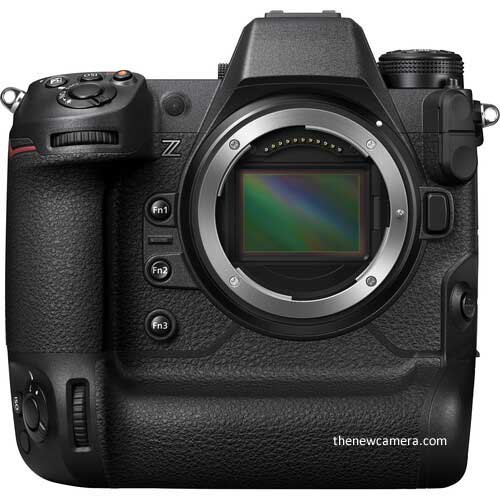
According to the latest rumours we have from Rumor Mills, Nikon ZR — and here ZR stands for RED — Nikon RED series consumer grade cinema camera with Z Series based body design, coming in Q4 of 2025. Now, explore the key features of the Nikon ZR camera:
Nikon ZR Specification
-
24.5MP Partially-Stacked CMOS Sensor: Nikon ZR will use the Nikon Z6 Mark III sensor.
-
A large display screen: The ZR will have a large display screen, making it comfortable for professional video workflow.
-
Enhanced RED technology inside which means we will have RED decode RAW and advanced colour science. Obviously, more details will be revealed with time.
While looking at the initial set of specs, it doesn’t look like a Nikon Z6 Mark III rebranded edition. From the initial specs, it looks like Nikon is working hard to produce a very unique line of consumer-grade cinema cameras in collaboration with RED.
We will bring more updates as soon as we get any latest information related to the upcoming Nikon ZR camera. Don’t get confused with the Nikon ZFR, which is said to be an extension of the existing Nikon Z lineup with a high-resolution sensor. Also, take a look at the list of Nikon’s upcoming cameras for 2025.
The article “Nikon ZR coming in Q4 of 2025” written and updated by thenewcamera.com team on 4:01 pm, Friday, 16 May 2025, Greenwich Mean Time (GMT) | Follow us for more updates and Get LIVE RUMORS –> FACEBOOK | TWITTER | INSTAGRAM to get live news — > get live news + Nikon Rumors 24X7
source Nikonrumor.com
By admin, on May 5th, 2025
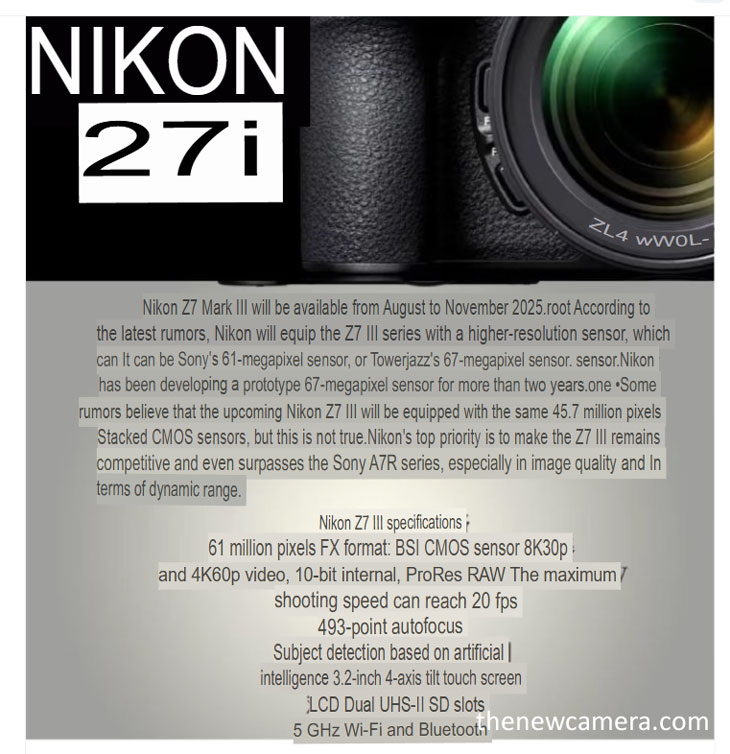
The photography community is buzzing with speculation about the Nikon Z7 Mark III, thanks to recently leaked specifications. The Independent Association of Photographers from China has labeled these leaks as fake, but are they entirely baseless? Let’s dive into the details of the leaked specs, their plausibility, and what they mean for Nikon’s high-resolution camera lineup.
Official Statement from the Independent Association of Photographers from China
—- This what they said about the information leaked above — Many people have been messaging me asking if this rumor is true, and many believe it, but the rumors about the Nikon Z7III are completely false.
Before saying anything is real or fake, one has to analyze its specifications. Does this leaked specification have any possibility of its existence in the upcoming Nikon Z7 Mark 3 camera? Does it have anything real inside it, whatever we have seen or read till now?
As you can see in the specifications, it is very clearly written: 61-megapixel FX-format BSI CMOS sensor and 8K 30 fps video recording capability with 4K 60 fps recording mode.
The timeline Z7 III arrival they’re sharing right now is from August to November 2025. We are very clearly known to the fact that Nikon is running late as per their scheduled announcement timeline, and the big reason behind that—as their representatives clearly mentioned, is that the demand for the Z7 series is less compared to the Z6 series. That’s why they are updating the Z6 III camera a bit early, as there are a lot of wedding photographers waiting for an update. But unfortunately, the Z7 series market space or the consumer base is slightly limited, and that’s why Nikon intentionally delayed its announcement.
When Will the Nikon Z7 Mark III Camera Arrive?
The Nikon Z7 Mark III camera is already running late, as we have already explained to you. It has been intentionally delayed, but Nikon hasn’t postponed the Z7 series. But, yes, it’s a fact that after the arrival of the Nikon Z5 II, the Z7 II has become one of the most old and outdated cameras in the Nikon Z lineup, so it raises a very high probability that Nikon may bring an update to this series before 2025 ends.
So that means yes, there is a very high probability that we may see the announcement of the Z7 Mark 3 in the year 2025.
Nikon Z7 Mark III Camera Sensor Resolution: Sony or TowerJazz?
Now, about the specifications—it has been very clearly mentioned that it may use Sony’s 61-megapixel or TowerJazz’s 67-megapixel sensor. And why have they said so? Is there any logical reason behind this?
We all know that Nikon has a very good relationship with Sony Imaging Division, and they are continuously using their sensors in most of their cameras. Now, as they have also mentioned TowerJazz, we do know that Nikon APS-C series like the Nikon Z50 Mark II, the Nikon Z30, and the Nikon Zfc’s 20-megapixel APS-C CMOS sensor is made by TowerJazz.
So yes, they can take sensors from TowerJazz, since they do have a good relationship with the company.
And one of the most important things that you might have forgotten is that Nikon China accidentally leaked the Z7 Mark 2 sample images back in 2022 with 67-megapixel resolution. But just after those images were published, Nikon China’s social media handlers deleted those images.
So there is a very high probability that they already have the working prototypes of the Nikon Z7 Mark 3 camera with multiple sensor variations, including sensors like 61 MP from Sony or 67 MP from TowerJazz.
Nikon Z7 Series: Resolution Over Speed
And the Nikon Z7 series is about resolution, not speed. If someone wants a hybrid solution, Nikon does have cameras like the Nikon Z8 and the Nikon Z9—both of them use the same sensor, which is a perfect combination of speed and resolution.
So yes, whatever text has been written in the leaked set of specifications doesn’t seem to be completely false. So we have to wait and watch what actually comes, since we already have this set of data in front of us. Now it’s about Nikon taking a step forward and announcing the long-awaited Z7 Mark 3 camera in front of us.
Key Features of the Nikon Z7 Mark 3 (Based on Leaks)
- 61 / 67 MP FX-Format BSI CMOS Sensor
- 8 K30p and 4K60p Video, 10-bit Internal, ProRes RAW
- Up to 20 fps Max Shooting
- 493-Point AF
- AI-Based Subject Detection
- 3.2″ 4-Axis Tilting Touchscreen LCD
- Dual UHS-II SD Slots
- 5 GHz Wi-Fi and Bluetooth
Nikon Z7 Mark 3 vs. Z7 Mark 2: Specification Comparison
| Feature |
Nikon Z7 Mark 3 (Leaked) |
Nikon Z7 Mark 2 (Current) |
| Sensor Resolution |
61 MP or 67 MP |
45.7 MP |
| Video Recording |
8K 30 fps, 4K 60 fps |
4K 60 fps |
| Sensor Manufacturer |
Sony or TowerJazz |
Sony |
| Expected Announcement |
August–November 2025 |
Released 2020 |
| Target Audience |
High-resolution shooters |
High-resolution shooters |
Why the Nikon Z7 Mark 3 Leak Seems Plausible
- Historical Precedent: Nikon China’s 2022 leak of 67-megapixel sample images suggests prototype development.
- Nikon’s Partnerships: Strong ties with Sony and TowerJazz make the rumored sensors feasible.
- Market Demand: The Z7 series’ focus on resolution aligns with the leaked high-megapixel specs.
- Delayed Timeline: Nikon’s prioritization of the Z6 III explains the Z7 III’s delay, but 2025 is a logical target.
While the Independent Association of Photographers from China dismisses the leaked specifications as fake, the details align closely with Nikon’s technological capabilities and market strategy. The rumored 61-megapixel or 67-megapixel sensor, combined with 8K video, positions the Z7 Mark 3 as a powerhouse for resolution-focused photographers. With a potential announcement in 2025, all eyes are on Nikon to confirm or deny these exciting leaks. And obviously, Nikon will keep silent over these without a doubt.
Reference
Nikon Z7 III – High Resolution Sample Image Accidentally Leaked by Nikon China [Rumor]
Also see – Nikon Upcoming Cameras 2025 | Canon Upcoming Cameras 2025 | Sony Upcoming Cameras 2025
ABout the author: The article “Nikon Z7 Mark III Leaked Specifications: Is the Rumored Camera Real?” written and updated by thenewcamera.com team on 3:04 pm, Monday, 5 May 2025, Greenwich Mean Time (GMT) | Follow us for more updates and Get LIVE RUMORS –> FACEBOOK | TWITTER | INSTAGRAM to get live news — > get live news + Nikon Rumors 24X7
By admin, on May 4th, 2025
The Nikon Z30 Mark II camera is an APS-C entry-level mirrorless camera from Nikon specifically made for content creators. The camera just hit an all-time low price of $596.95 with the 16-50mm kit lens in all the major online stores in the USA [B&H Store and Adorama]—a major discount from its original $790.95 launch price.
Is Nikon clearing up the stock inventory of the Nikon Z30 camera to make a clear way for the highly anticipated Nikon Z30 Mark II camera with the recent rumors of camera registrations as well? Considering the lifecycle of an entry-level camera, all these factors point to an imminent announcement. Now let’s dive into some facts.
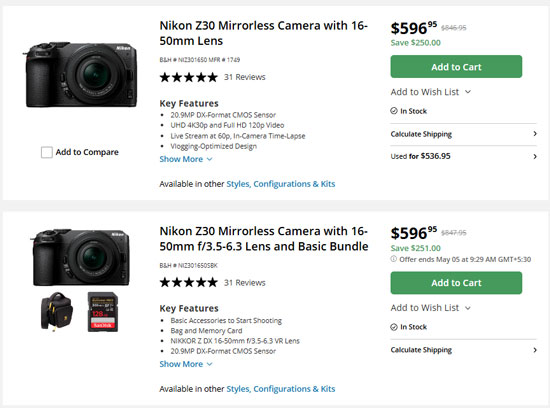
Why the Nikon Z30 price drop signals the Z30 Mark II announcement?
Deep discounts on cameras generally indicate manufacturers are preparing for the launch of the successor. As we all know, the Nikon Z30 is approximately 2 years old and was announced back in June 2022. At the time of the Nikon Z30 camera announcement, the direct competitors were the Sony ZV-E10 and the Canon R50.
But as of 2025, we now have the successor of the Sony ZV-E10, the Sony ZV-E10 Mark II camera with upscaled core specifications. At the very same time, Canon has also updated their entry-level Canon R50 camera with the Canon R50v.
In some markets, used Z30 bodies are selling for as low as $459. This suggests that Nikon is aggressively clearing the stocks to make way for the Nikon Z30 Mark II camera. A similar price drop was witnessed in the Nikon Z50 before the arrival of the Nikon Z50 Mark II camera.
Adding fuel to the fire, Nikon recently registered a new camera in the wireless certification agency with the model code N2410. So it doesn’t surprise us that Nikon plans to introduce a new camera soon. Now if you look at the list of upcoming Nikon cameras of 2025, then the list includes Nikon Z7 Mark III, Nikon Z9 Mark II, as well as the Nikon Z30 Mark II. Now, among all these three cameras in the entry-level zone, the Z30 Mark II is a very strong contender and needs a refresh as soon as possible since it’s losing its market compared to its competitors, specifically the Canon R50v.
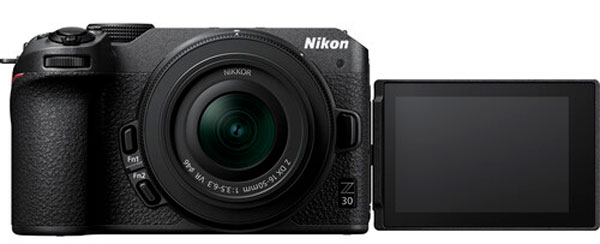
What should we expect from the upcoming Nikon Z30 Mark II camera?
We have already discussed the core specifications of the camera in our previous post. Now, just to remind you again—
Nikon Z30 Mark II Specifications [Expected]
Imagine and Processor:
- 20.9MP DX-Format CMOS Sensor
- EXPEED 7 Image Processor
Video Specs:
- 125 Minutes Recording Time Limit in 4K
- UHD 4K60p Video Recording (with crop mode)
- Full HD 120fps Slow-Motion Recording
- Live Streaming at 60p
- Product Review mode
- 10 Bit Internal recording (Via HDMI)
Autofocus System:
- Hybrid AF with Improved Eye and Face Detection
- Subject Detection for 9 Types (animals, vehicles, etc.)
Screen and Viewfinder:
- 3″ 1.04m-Dot Free-Angle Touchscreen LCD (180° tilting for vlogging)
Audio and Connectivity:
- Built-In Stereo Mic with Wind Noise Reduction
- External Mic 3.5mm
- New Tally Lamp Design for Recording Indicator
- Wi-Fi and Bluetooth for Seamless Connectivity
Vlogging Features:
- Vlogging-Optimized Design
- Dedicated Selfie Controls
- Picture Control Button for Quick Adjustments
Shooting and Storage:
- ISO 100-51200
- Up to 11 fps Continuous Shooting
- Single SD Memory Card Slot
Excluded Features (To Protect Z50 II Sales):
- No electronic viewfinder (to keep the Z30 Mark II focused on vlogging and content creation)
- Photographic enhancements like burst shooting at 30 fps are reserved for Z50 II.
- Market Segmentation: Nikon will likely reserve 10-bit internal recording for the Nikon Z50 Mark II camera, to maintain its appeal to semi-professional users and protect its future sales.
- Target Audience: The Z30 series targets vloggers and casual content creators who don’t spend much time grading 10-bit videos, they give priority to ease of use and affordability over advanced video specifications. Offering a 10-bit recording might not align with this audience’s actual needs.
Why the Nikon Z30 stock clearance is an excellent opportunity for you
For those who are not waiting for the Nikon Z30 Mark II camera, the current stock clearance sale is a great opportunity to grab one of the best low-light performing cameras in the APS-C range. Since the same 20-megapixel sensor is being used in the Nikon Z50 Mark II camera, the Zfc camera, and even the same sensor will likely be used in the Z30 Mark II camera. So, if you are a photographer and looking for a budget body, without a doubt, the Nikon Z30 (or its Mark II) is one of the best opportunities right now. At the very same time, it also records Full HD videos up to 2 hours 15 minutes and 4K up to 30 minutes. Let’s have a look at its major offerings.
The Z30 remains a fantastic choice for beginners and vloggers, offering:
-
A 20.9MP APS-C sensor for sharp stills and 4K video.
-
A fully articulating 3.0″ touchscreen for easy framing.
-
Hybrid autofocus with eye and face detection.
-
Up to 2 hours 15 minutes of continuous recording, ideal for long takes.
-
Compatibility with Nikon’s Z-mount lenses and F-mount lenses via the FTZ II adapter.
 Canon R50V – A Recent entry-level camera from Canon with 10-bit 4 K 60p video recording capability and Clog support. Nikon’s strategy to capture the content creator market
Nikon is already putting a lot of focus and effort, as you can see in the entry-level full-frame cameras like the Nikon Z5 II. We are having the ability to record in 12-bit RAW, 10-bit LOG video, and Red camera LUTs are also there to give an enhanced cinematic experience to users. Similarly, being a hybrid camera, the Nikon Z50 Mark II features class-leading video core specifications.
But Nikon’s entry-level range is now weak and needs an upgrade. If they fail to do so in a proper timeline, they will lose a big market share for sure—since Canon R50v has now arrived with exceptional video core specifications at very similar prices to the Nikon Z30.
We all know Nikon is planning to introduce the Z9 Mark II camera before the Winter 2026 Olympics. But refreshing the entry-level Nikon Z30 is very essential and a requirement of the situation. If they update the Z30 in time, they can keep the entry-level line competitive and appealing to younger creators.
When will the Nikon Z30 Mark II camera arrive?
We expect that the Nikon Z30 Mark II camera will arrive in Q4 of 2025 or Q1 of 2026. Nikon may shift the Z30 Mark II camera announcement to January 2026 at CES or maybe at CP+ in February 2026.
But that’s our expectation. As we all know, Nikon generally takes 3 months to announce a new camera once the wireless registration happens, and as we all know, the Z9 II, the Z7 III, and the Z30 Mark II are in line for announcement.
The post “Nikon Z30 Mark II Coming Soon? Z30 Prices Hit Record Low” appeared first on thenewcamera.com | Written by thenewcamera.com team on 3:53 am, Sunday, 4 May 2025 Greenwich Mean Time (GMT) Follow us on our social pages FACEBOOK | TWITTER | INSTAGRAM to get live Camera News + Nikon Rumors 24X7.
By admin, on April 24th, 2025
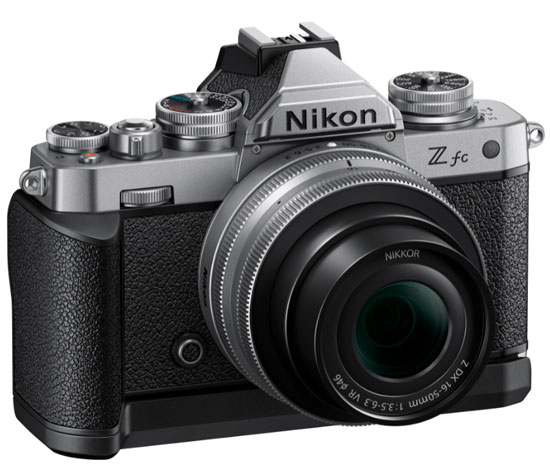
Nikon announced multiple firmware updates for its cameras; among the three, Nikon ZFC has the longest list of updates. Take a look at the details below
Z fc firmware Ver.1.80
• The following phenomena have been fixed.
– When connected to SnapBridge and Wi-Fi, if the Setup menu’s Connect to smartphone > Communications when powered off is set to On, and then the camera is turned off and the lens is removed, the values would remain displayed on the LCD panel.
– If you looked through the viewfinder with the picture monitor closed, and then pressed the release button halfway just before pressing the playback button to switch to the playback screen, the display in the viewfinder might not be correct.
– If you looked through the viewfinder with the Picture Control settings screen displayed from the i menu, the display might not be correct.
Z 50 Firmware Ver.2.60
• Fixed an issue where frames would not advance correctly when pinching out to enlarge an image taken in portrait orientation.
COOLPIX P1000 Firmware Ver.1.8
• Fixed an issue that occasionally caused the camera to stop responding to operations when taking continuous shots.
Follow us on our social pages FACEBOOK | TWITTER | INSTAGRAM to get live Camera News + Nikon Rumors 24X7
By admin, on April 17th, 2025
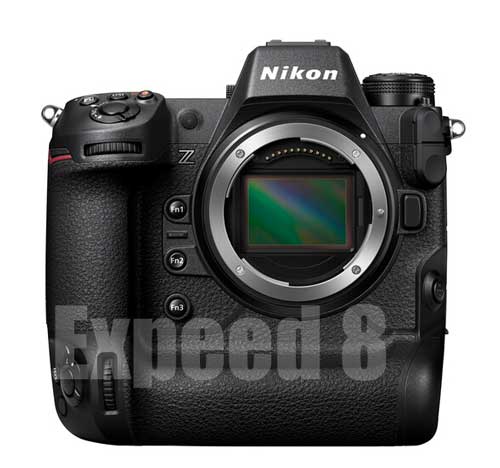
There has been talk that we will have the new Nikon Z9 Mark II camera before the 2026 Olympics. If you look at the trend in the past. We have witnessed that Nikon and Canon were usually seen announcing their flagship bodies before the Olympics. Now it’s almost 4 years since the Z9 — the original Z9 was announced before the 2022 ( before Winter Olympics). Just after that, Nikon Z8 was announced in May 2023, which carries approximately 90% of the same core specifications we have in this Z8., The Nikon Z8 announcement has also disturbed the sales cycle of the Nikon Z9 camera, and many professionals prefer to buy the Nikon Z8 instead of the Nikon Z9.
Matt Irwin (Nikon Pro) has said in one his recent video that there strong possibility “Winter Olympics is a long way off but of course it’s not it’s roughly a year away and thus that sort of time frame would make a lot of sense to me and it would get us back to a Olympic cycle which is something that Nikon kind of adhered to mostly adhered to through the DSLR flagship era…”
Table: Nikon Flagship Camera Releases and Olympic Connections
| Olympic Event |
Year |
Nikon Flagship Camera |
Release Date |
Camera Type |
|
| Sydney Summer Olympics |
2000 |
Nikon D1H |
February 2001 (announced 2000) |
DSLR |
|
| Athens Summer Olympics |
2004 |
Nikon D2H/D2Hs |
July 2003 (D2H), February 2005 (D2Hs) |
DSLR |
|
| Beijing Summer Olympics |
2008 |
Nikon D3 |
August 2007 |
DSLR |
|
| London Summer Olympics |
2012 |
Nikon D4 |
January 2012 |
DSLR |
|
| Rio Summer Olympics |
2016 |
Nikon D5 |
January 2016 |
DSLR |
|
| Tokyo Summer Olympics (postponed to 2021) |
2020/2021 |
Nikon D6 |
February 2020 |
DSLR |
|
| Beijing Winter Olympics |
2022 |
Nikon Z9 |
October 2021 |
Mirrorless |
|
| Paris Summer Olympics |
2024 |
Nikon Z9 (firmware updates) |
No new flagship (firmware updates in 2023–2024) |
Mirrorless |
|
| Milan/Cortina Winter Olympics |
2026 |
Nikon Z9 II (rumored) |
Expected late 2025/early 2026 |
Mirrorless |
|
The Winter Olympics will start from February 6 to February 22, in 2026, so there is a very high probability we will see the announcement of the Nikon Z9 Mark II camera in the 4th quarter of 2025, since it has to become available during the Olympics for shooting.
Nikon Z9 Mark II Camera Expected specification
-
A 45 megapixel full-frame CMOS sensor inside the camera
-
Introduction of Expeed 8 image processor
-
Enhanced video integration from RED video technology, potentially more improved 8K video capabilities
-
Enhanced with Expeed 8 image processor, a lot of work can be done in the AI AF zone as well as in the performance part of the camera
-
Content Credentials: Support for authenticity features
A late 2025 announcement (development announcement rumored) with a release in early 2026 leaves a tight window for pros to adopt the Z9 II before the Olympics. Nikon’s rushed Z9 launch in 2021 faced criticism for incomplete features, later fixed via firmware, suggesting a need for thorough testing. Let’s see what they can bring in front of us in Z9 II.
Support us – Use or affiliate link Amazon.com | B&H Store | Adorama.com for the next purchase u make – it helps us 🙂
Follow us on our social pages FACEBOOK | TWITTER | INSTAGRAM to get live Camera News + Nikon Rumors 24X7
By admin, on April 15th, 2025
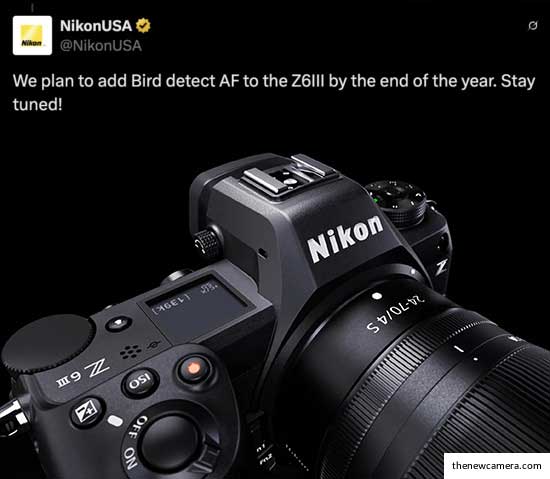
Today Nikon confirmed that bird eye autofocus mode is coming to the Nikon Z6 Mark III camera later this year in their social media post, that’s really great news since cameras like Nikon Z50 II, Z5II and Nikon Zf, which come at a lower price point than the Nikon Z6 III, now have bird eye autofocus mode. And Z6 III users are waiting for a long time to have it.
And we had reported back in November 2024 that Nikon is working on Z6 Mark 3 bird eye autofocus mode and they will roll it out as they are ready for it, and now we got the final confirmation from Nikon itself.
Best Lenses for Nikon Z6 III
Follow us on our social pages FACEBOOK | TWITTER | INSTAGRAMto get live Camera News +Nikon Rumors 24X7
By admin, on April 15th, 2025
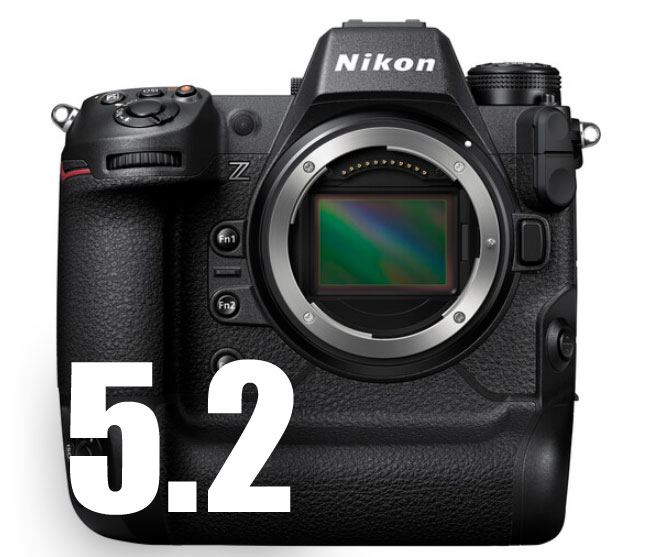
Nikon Z9 Firmware 5.2 Released in China and japan, and I hope and expect it will become available to other countries soon. Take a look at the details of the update
Translated version of the same
- • Now supports the “NX Field”* function, a remote photography system for businesses.
- * For an overview of NX Field and instructions on how to use NX Field, please visit the NPS website.
- NPS (Nikon Professional Services) website (English)
- *The smart device app “NX Field” is not available in some countries and regions.
- • The following bugs have been fixed:
- – In rare cases, when pressing the playback button after repeatedly shooting continuous shots, not all images would be displayed correctly.
- – In M mode, when taking continuous shots after changing the exposure, the exposure would occasionally be incorrect.
- – When a camera with the following settings is used as a linked release remote camera, the AF on the remote camera will be activated when the master camera’s shutter is pressed halfway.
- ▸ [Customization Menu] > a6 [Half-press AF lens activation] set to [Off]
[Custom Setting Menu]>a6 [Half-Press Shutter Drive AF]> [AF-ON Button Only]

What Is Nikon NX Field?
For those who don’t know about NX Field, the Nikon NX Field is a professional-grade remote shooting app from Nikon currently available for iOS apps for iPhones and iPads, first launched in June 2021, designed for agencies and pros to cover any event or game with multiple cameras flawlessly
- Control up to 10 cameras (one master, nine remotes) via wired LAN, wireless LAN, or 4G/5G networks.
- Adjust settings remotely, from autofocus to exposure, using the NX Field app on a smartphone or tablet (iPhone 8 or later, iPad Pro 2018+).
- Transfer images instantly to FTP servers for rapid publishing—crucial for newsrooms and sports agencies.
- Sync shutters for multi-angle shots, perfect for capturing that game-winning goal from every perspective.
Added support for enterprise users’ “NX Field” remote shooting system. Take a look at the features of the NX field software that you can do with your app
- Realizing shutter release, setting changes, and FTP image transmission of up to 10 remote cameras synchronized with a master camera via wired LAN cable.
- Wired LAN connection ensures reliable remote camera shutter release even in situations where many photographers are shooting with remote cameras via radio waves at once.
- Synchronization is also compatible with Wi-Fi connection using WT-5/6 Wireless Transmitters.
- The status of remote cameras, including connection status, latest shutter-release time, etc., can be confirmed from a master camera in order to avoid unintended errors.
- A smart device with the NX Field application installed can be used to change settings and check live view images of remote cameras, allowing for operation in narrow spaces or remote shooting from a distant location.
- Automatic FTP image transmission during synchronized shooting of a master and remote cameras as well as while changing camera settings via a smart device with the NX Field application.
- Easy recovery from FTP server network errors by remotely reconnecting to the server.
- Easy switching between shooting with a master camera only, with remote cameras only, or with both the master and remote cameras, which helps to avoid capturing unnecessary images and ensures that only the desired images are transferred.
- Autofocusing is possible with remote cameras from a master camera or smart device with the NX Field application.
- Remote shooting via the Internet, such as 4G/5G mobile network, is possible.
- The robotics of Mark Roberts Motion Control Limited can also be synchronized with a master camera.
- Silent remote shooting with compatible Z series cameras* for expanded shooting scenarios.
The content is updated on April 15, 2025
Follow us on our social pages FACEBOOK | TWITTER | INSTAGRAM to get live Camera News + Nikon Rumors 24X7
source Nikon Japan www.maging.nikon.com/imaging/lineup/software/nx_field/
|
KEEP THIS BLOG ALIVE - Support New Camera Buy Canon Lenses, Buy Music CD or Digital Camera at amazon it helps this site, and you do not pay anything extra, it is just a way to help support this site.

|















